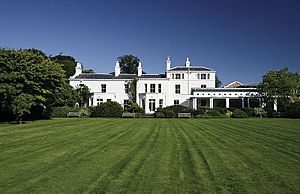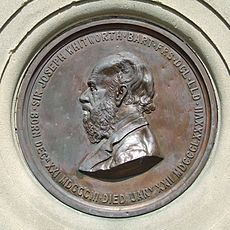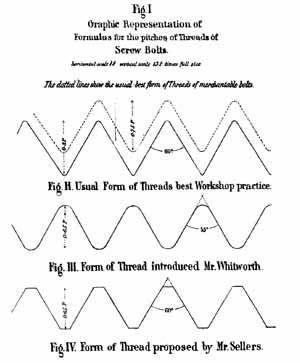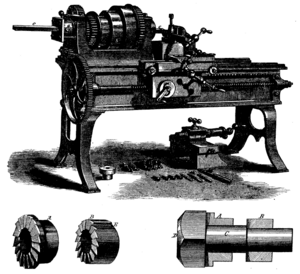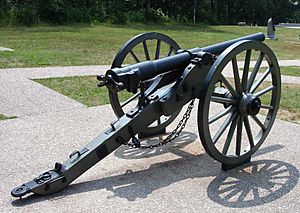Joseph Whitworth facts for kids
Quick facts for kids
Sir Joseph Whitworth
|
|
|---|---|
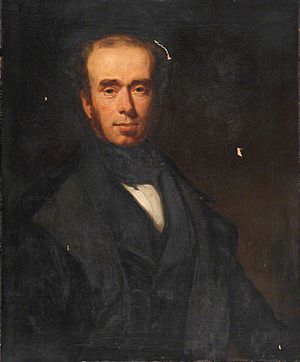
by Unknown artist, Joseph Whitworth c.1846
|
|
| Born | 21 December 1803 |
| Died | 22 January 1887 (aged 83) |
| Occupation | Engineer |
| Engineering career | |
| Institutions | Royal Society Institution of Mechanical Engineers |
| Significant advance | Whitworth standardised screw threads |
| Awards |
FRS (1857)
Albert Medal (1868) |
Sir Joseph Whitworth, 1st Baronet (born December 21, 1803 – died January 22, 1887) was a brilliant English engineer, inventor, and generous helper of others. He is famous for creating a standard system for screw threads in 1841. This system, called the British Standard Whitworth, made it much easier to build machines and other things.
Whitworth also invented the Whitworth rifle, which was incredibly accurate. It was sometimes called the "sharpshooter" and is seen as one of the first sniper rifles.
In 1869, Queen Victoria made him a baronet, which is a special title. When he passed away in 1887, he left a lot of his money to help the people of Manchester. His gifts helped fund places like the Whitworth Art Gallery and Christie Hospital. Streets and buildings in Manchester, like Whitworth Street and Whitworth Hall, are named after him.
His company later joined with another to become Armstrong Whitworth in 1897.
Biography of Joseph Whitworth
Early Life and Learning
Joseph Whitworth was born in Stockport, England. His father was a teacher and a minister. From a young age, Joseph was very interested in machinery. He went to school near Bradford and soon showed a natural talent for how machines work.
Starting His Career in Engineering
After school, Whitworth became an apprentice (a trainee) at a cotton mill. He quickly learned how the machines worked. Even then, he noticed that the machines weren't very accurate. This made him want to build machines with much greater precision.
After his apprenticeship, he worked as a mechanic in Manchester. Then he moved to London. There, he worked for famous inventors like Henry Maudslay, who invented the screw-cutting lathe. He also worked with James Nasmyth, who invented the steam hammer.
While working for Maudslay, Whitworth became very skilled. He helped create precise machine tools. He also improved how machine frames were made, making them stronger and lighter. Whitworth even helped build parts for Charles Babbage's early computer, the Difference engine.
Building His Own Business
In 1833, Whitworth started his own business in Manchester. He made lathes and other machine tools. His products were known for their very high quality. In 1844, he introduced the "thou" as a unit of measurement. A thou is one-thousandth of an inch, used for very small measurements.
Whitworth became very successful and received many awards for his designs. He believed strongly in technical education. He supported the new Mechanics' Institute in Manchester. He also helped start the Manchester School of Design.
In 1868, he created the Whitworth Scholarship. This scholarship helps young people study mechanical engineering. He gave a large sum of money to the government for these scholarships. In 1869, Queen Victoria honored him by making him a baronet.
Whitworth Scholarships Today
The Whitworth Scholarship program still exists today. It awards scholarships to talented engineers each year. These scholarships help students who have strong academic and practical skills. They are for those who want to succeed in the engineering industry. The money for these scholarships still comes from Sir Joseph's original gift. The Institution of Mechanical Engineers now manages the awards.
The Whitworth Society
In 1923, the Whitworth Society was created. It supports all Whitworth Scholars and promotes engineering in the UK. The society brings together those who have benefited from Sir Joseph Whitworth's generosity.
Death and Legacy
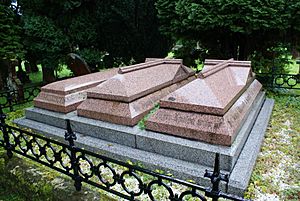
Sir Joseph Whitworth passed away in January 1887 at the age of 83. He was in Monte Carlo, hoping to improve his health. He was buried in Darley Dale, Derbyshire.
He left instructions for his fortune to be used for good causes. His money still helps people today. A big part of his generosity was setting up the Whitworth Scholarships. These scholarships continue to help young engineers. Part of his money also helped create the Whitworth Art Gallery and the Whitworth Institute.
Memorials and Lasting Impact
Sir Joseph Whitworth's generosity had a huge impact on Manchester. A large part of his money went to Owens College, which is now part of the University of Manchester. The Whitworth Hall was built thanks to his legacy.
The university's Whitworth Art Gallery and the nearby Whitworth Park were also created from his gifts. Whitworth Street in Manchester city center is named after him. Even a cycleway near the university is called Whitworth Lane. In Darley Dale, there is also a Whitworth Park. The Whitworth Building at the University of Manchester is named in his honor.
Whitworth's Important Work
Accuracy and Standardisation
Whitworth made it easier to create very flat surfaces in the 1830s. He used a method with "engineer's blue" and scraping tools. This led to many new precision instruments being developed.
In 1840, he invented a new measuring technique called "end measurements." This system was incredibly precise, able to measure down to one millionth of an inch. He showed this amazing accuracy at the Great Exhibition in 1851.
In 1841, Whitworth created a standard for screw threads. He set a fixed angle and a standard "pitch" (how far apart the threads are) for different sizes. This quickly became the first national standard system. It was adopted by railway companies and became widely used. It is now known as the "British Standard Whitworth" (BSW).
The Whitworth Rifled Musket
The British government asked Whitworth to design a better rifle. The old rifle had problems during the Crimean War. Whitworth's new rifle, the Whitworth rifle, was different. It had a smaller, hexagonal (six-sided) barrel. It fired a special hexagonal bullet.
This rifle was much more accurate than the old one. In tests in 1859, it performed much better. However, it was more expensive to make and sometimes got dirty easily. So, the British government did not adopt it. But the French Army used it.
Some Whitworth rifles were also used by the Confederate states during the American Civil War. They were called "Whitworth Sharpshooters" because of their amazing accuracy. They could hit targets very well from far away.
In 1860, Queen Victoria opened the first meeting of the National Rifle Association. She fired a Whitworth rifle from a special stand. She hit the bull's eye from 400 yards away!
Whitworth Rifled Cannon
Whitworth also designed a large rifled cannon. This gun could fire a 12-pound projectile about 6 miles! It had a special spirally-grooved projectile. The British Army did not use it, preferring guns from Armstrong. However, this cannon was used in the American Civil War.
To make his gun barrels stronger, Whitworth invented a process called "fluid-compressed steel." This involved casting steel under pressure. He built a new steel factory near Manchester for this.
See also
In Spanish: Joseph Whitworth para niños


